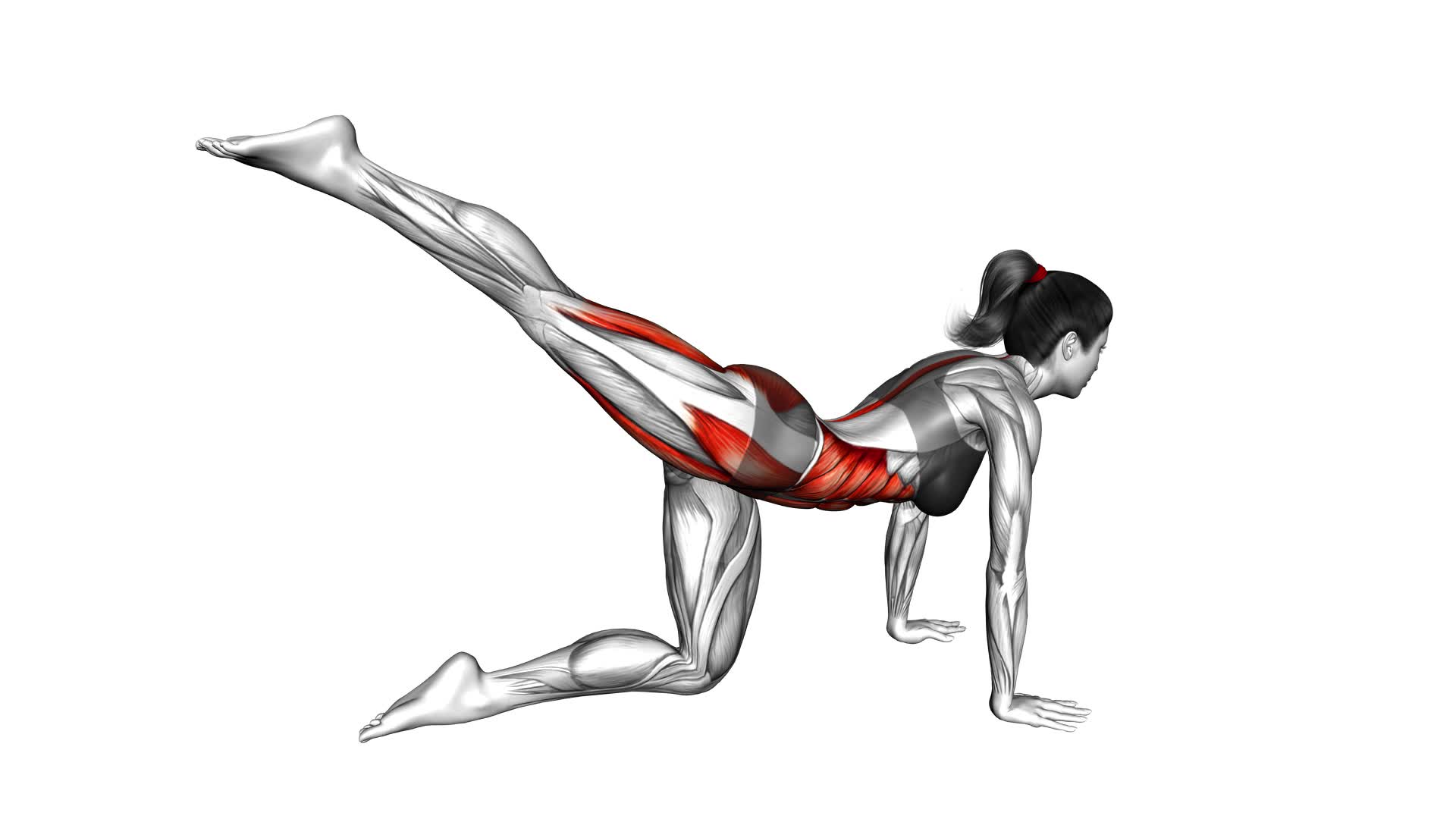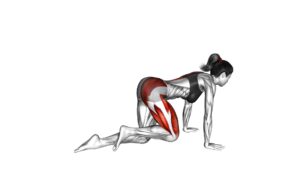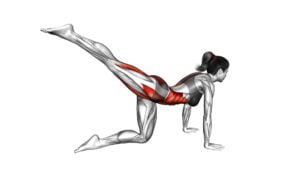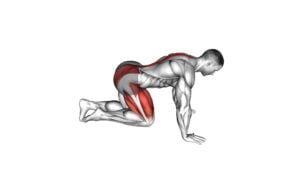Kneeling Single Kickback (female) – Video Exercise Guide & Tips

Are you looking for an effective exercise to target your glutes? Look no further!
Watch This Exercise Video
In this video exercise guide, we'll walk you through the Kneeling Single Kickback, specifically designed for women.
With just a few simple steps, you'll learn proper form and technique to maximize your results.
Whether you're a beginner or a seasoned fitness enthusiast, this exercise can be easily modified to suit your fitness level.
Get ready to sculpt and strengthen your glutes with this powerful move. Let's kick it!
Key Takeaways
- The kneeling single kickback exercise targets the gluteus maximus, strengthens and tones the glutes, and engages the hamstrings and core muscles for stability.
- Proper form and technique, including maintaining a neutral spine and avoiding arching or rounding, is essential for maximizing the effectiveness of the exercise.
- Variations of the exercise can be done using different equipment such as resistance bands, dumbbells, or unstable surfaces, providing variety and targeting different muscle groups.
- To maximize results, gradually increase the intensity of the workout by adding more resistance or repetitions, and incorporate effective time management by planning workouts in advance for consistency and progress.
Equipment Needed
To perform the kneeling single kickback exercise, you'll need equipment. The good news is that the equipment required for this exercise is quite common and easily accessible. The main piece of equipment you'll need is a resistance band. This elastic band provides the necessary resistance to effectively engage your glutes and hamstrings during the exercise. You can choose a resistance level that suits your fitness level and goals.
If you don't have a resistance band, don't worry. There are alternative options available. You can use ankle weights or even a cable machine with an ankle attachment to achieve a similar effect. These options will still allow you to target your glutes and hamstrings effectively.
Now that you know what equipment you need, let's move on to the next section, where we'll discuss the proper form and technique for performing the kneeling single kickback exercise.
Proper Form and Technique
Start by positioning yourself on all fours, with your hands directly under your shoulders and your knees directly under your hips. This is the starting position for the kneeling single kickback exercise. Here are some tips to ensure proper form and technique:
- Keep your core engaged throughout the movement to maintain stability.
- Maintain a neutral spine by keeping your back flat and avoiding any arching or rounding.
- As you extend your leg back, focus on squeezing your glutes to activate the muscles effectively.
- Keep your leg in line with your body, avoiding any excessive lifting or swinging.
- Control the movement by slowly extending your leg and then returning to the starting position.
The kneeling single kickback exercise offers several benefits. Firstly, it targets the gluteus maximus, the largest muscle in the buttocks, helping to strengthen and tone this area. Additionally, it engages the hamstrings, which are located at the back of the thigh, and the core muscles for stability. By incorporating this exercise into your workout routine, you can improve your overall lower body strength and enhance the shape and definition of your glutes.
Now that you understand the proper form and technique for the kneeling single kickback, let's explore some variations and modifications to challenge yourself even further.
Variations and Modifications
To further challenge yourself and increase the effectiveness of the kneeling single kickback exercise, consider incorporating variations and modifications.
These can help target different muscle groups and add variety to your workout routine.
One variation you can try is the kneeling single kickback with a resistance band. Simply attach a resistance band to a stable anchor point and loop it around your foot as you perform the exercise. This will add resistance and make the movement more challenging.
Another modification is the kneeling single kickback with a dumbbell. Instead of using just your body weight, hold a dumbbell in your hand and extend your leg back, focusing on contracting your glutes. This will increase the resistance and intensity of the exercise.
You can also try performing the exercise on an unstable surface, such as a Bosu ball or a balance pad, to engage your core and improve stability.
By incorporating these variations and modifications, you can keep your workouts interesting and continue to progress.
Now, let's move on to the next section and discuss common mistakes to avoid when performing the kneeling single kickback exercise.
Common Mistakes to Avoid
When performing the kneeling single kickback exercise, be mindful of the following common mistakes to avoid:
- Using momentum: It's important to control the movement and not rely on momentum to lift your leg. Slow and controlled movements ensure that you're effectively targeting the glute muscles and avoiding injury.
- Neglecting proper form: Ensure that your back remains straight and your core engaged throughout the exercise. Avoid arching your back or rounding your shoulders, as this can lead to strain or injury.
- Lifting too high: While it may be tempting to lift your leg as high as possible, it's important to focus on the quality of the movement rather than the height. Lift your leg to a point where you can feel your glutes engage, but without compromising your form.
By avoiding these common mistakes, you can maximize the benefits and minimize the risk of injury during the kneeling single kickback exercise.
This exercise primarily targets the gluteus maximus, helping to strengthen and tone the buttocks. It also engages the hamstrings and lower back muscles, improving overall lower body strength and stability.
As with any exercise, it's important to take precautions. Start with a weight that's appropriate for your fitness level and gradually increase as you become stronger. If you experience any pain or discomfort during the exercise, stop immediately and consult a fitness professional or healthcare provider. Remember to always listen to your body and modify the exercise as needed to ensure a safe and effective workout.
Tips for Maximizing Results
To maximize your results with the kneeling single kickback exercise, focus on maintaining proper form techniques and implementing effective workout strategies.
By ensuring that your back remains straight and your core engaged throughout the movement, you can target your glutes and hamstrings more effectively.
Additionally, varying your resistance and incorporating progressive overload can help challenge your muscles and promote growth over time.
Proper Form Techniques
For optimal results, focus on maintaining proper form during the kneeling single kickback exercise. Proper form not only ensures that you target the correct muscles but also helps prevent injury. Here are some tips to help you maximize your workout benefits and muscle activation:
- Keep your core engaged throughout the exercise to maintain stability and protect your lower back.
- Use a controlled and slow movement while kicking back your leg to fully engage your glutes.
- Avoid arching your back or swinging your leg to maintain proper alignment and isolate the glute muscles.
By following these form techniques, you can effectively target and activate your glutes, hamstrings, and core muscles during the kneeling single kickback exercise.
Effective Workout Strategies
To maximize your results and get the most out of your workout, it's essential to implement effective strategies while performing the kneeling single kickback exercise.
One important strategy is to focus on increasing workout intensity. This can be done by gradually adding more resistance or increasing the number of repetitions. By challenging your muscles, you can promote strength and muscle growth.
Another strategy is effective time management. Plan your workouts in advance and set aside dedicated time to focus on your fitness goals. This will help ensure that you stay consistent and make progress.
By incorporating these strategies into your routine, you can optimize your workouts and achieve the best possible results.
Now, let's move on to the next section and explore a sample workout routine.
Sample Workout Routine
To maximize your results and achieve your fitness goals, it's important to have an effective workout routine.
As a beginner, it's crucial to focus on exercises that are suitable for your level of fitness and gradually increase the intensity.
Structuring your workouts with a combination of strength training, cardio, and flexibility exercises will help you build strength, burn calories, and improve overall fitness.
Effective Exercises for Beginners
Get started with effective exercises for beginners by incorporating a kneeling single kickback into your workout routine. This exercise is great for targeting your glutes and hamstrings while also engaging your core.
Here are some benefits of strength training for beginners:
- Increases muscle strength and endurance
- Improves bone density and reduces the risk of osteoporosis
- Boosts metabolism and aids in weight loss
To stay motivated when starting a fitness routine, try these tips:
- Set realistic goals and track your progress
- Find a workout buddy or join a fitness class for accountability
- Mix up your routine to prevent boredom and plateau.
Now that you know the benefits and how to stay motivated, let's move on to the next section about how to structure your workouts for maximum effectiveness.
How to Structure Workouts
Now that you understand the benefits of strength training and how to stay motivated, let's explore how to structure your workouts for maximum effectiveness.
When it comes to workout frequency, consistency is key. Aim for at least three to four sessions per week, allowing your body enough time to recover between workouts.
Setting goals is crucial in order to track your progress and stay motivated. Whether it's increasing the amount of weight you can lift or improving your endurance, having specific goals will help you stay focused and push yourself during each workout.
To structure your workouts effectively, consider incorporating a mix of cardio, strength training, and flexibility exercises. This will ensure that you're targeting different muscle groups and achieving a well-rounded fitness routine.
Frequently Asked Questions
How Many Sets and Reps Should I Do for the Kneeling Single Kickback Exercise?
To determine the number of sets and reps for the kneeling single kickback exercise, it's important to consider your fitness level and goals. Generally, starting with 2-3 sets of 10-12 reps is a good guideline.
However, if you're a beginner, you may want to modify the exercise by using lighter weights or no weights at all.
Additionally, to prevent lower back pain during the exercise, focus on engaging your core and maintaining proper form throughout the movement.
Can I Use Dumbbells or Resistance Bands Instead of a Cable Machine for This Exercise?
Yes, you can definitely use dumbbells or resistance bands instead of a cable machine for the kneeling single kickback exercise. This allows for more versatility and convenience in your workouts. Using alternative equipment for the exercise can still effectively target and strengthen your glutes.
It's important to choose a weight or resistance level that challenges you without compromising your form. Incorporating these variations can provide additional benefits for your glute muscles.
Is It Normal to Feel a Burn in My Glutes and Hamstrings While Performing the Kneeling Single Kickback?
Feeling a burn in your glutes and hamstrings during the kneeling single kickback exercise is completely normal. This burn sensation indicates that your muscles are being activated and working hard. It shows that you're targeting the right muscle groups and engaging them effectively.
Keep in mind that proper form and technique are crucial to maximize muscle activation and prevent injury. If the burn becomes too intense or painful, you may need to adjust the weight or resistance level to ensure a safe and effective workout.
Can I Incorporate the Kneeling Single Kickback Into My Leg Day Routine?
Yes, you can definitely incorporate the kneeling single kickback into your leg day routine. It's a great exercise for targeting the glutes and hamstrings.
But did you know that it also has benefits for your core strength? By engaging your core to maintain stability throughout the movement, you're giving your abs and lower back an extra workout.
How Long Should I Hold the Contraction at the Top of the Movement During the Kneeling Single Kickback Exercise?
To maximize the effectiveness of the kneeling single kickback exercise, focus on holding the contraction at the top of the movement for a brief moment. This will engage your glutes and help build strength.
However, avoid holding the contraction for too long, as it can lead to muscle fatigue and potential injury. Remember to maintain proper form and listen to your body's limits.
Incorporating this tip will enhance your leg day routine and prevent any unwanted injuries.
Conclusion
In conclusion, the kneeling single kickback exercise is an effective way for women to target and strengthen their glutes. By using proper form and technique, variations and modifications can be made to suit individual fitness levels and goals.
Avoiding common mistakes and following the provided tips can help maximize results. Incorporating this exercise into a well-rounded workout routine can contribute to overall strength and muscle tone.

Author
Years ago, the spark of my life’s passion ignited in my mind the moment I stepped into the local gym for the first time. The inaugural bead of perspiration, the initial endeavor, the very first surge of endorphins, and a sense of pride that washed over me post-workout marked the beginning of my deep-seated interest in strength sports, fitness, and sports nutrition. This very curiosity blossomed rapidly into a profound fascination, propelling me to earn a Master’s degree in Physical Education from the Academy of Physical Education in Krakow, followed by a Sports Manager diploma from the Jagiellonian University. My journey of growth led me to gain more specialized qualifications, such as being a certified personal trainer with a focus on sports dietetics, a lifeguard, and an instructor for wellness and corrective gymnastics. Theoretical knowledge paired seamlessly with practical experience, reinforcing my belief that the transformation of individuals under my guidance was also a reflection of my personal growth. This belief holds true even today. Each day, I strive to push the boundaries and explore new realms. These realms gently elevate me to greater heights. The unique combination of passion for my field and the continuous quest for growth fuels my drive to break new ground.







